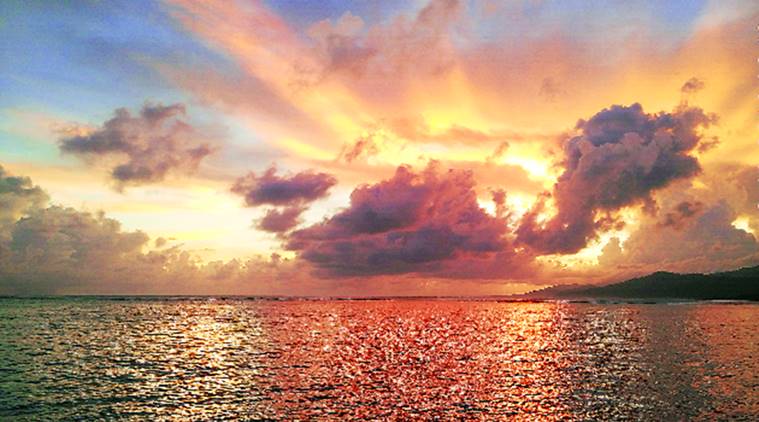 Lo and Behold! A gorgeous sunrise over the island of Samoa. (Source: Indrajit Bose)
Lo and Behold! A gorgeous sunrise over the island of Samoa. (Source: Indrajit Bose)
As I deboard the aeroplane, I am hit by a sense of deja vu. The salty twang in the air and the humidity take me back to my childhood, to the beach vacations in Odisha’s Puri, where I have spent many happy days by the sea. But, here I am, nearly 12,000 km away — in Apia, the capital city of the small island state of Samoa in the Pacific Ocean, and I am already feeling at home.
There is a lilt in the way Samoans refer to their country and I learn soon enough that I had been mispronouncing Samoa all along. The correct way to say it is “Saa-moa”! My window in to the country is Frederick, who drives me around the island state. On the way from the airport to the hotel, he introduces himself as a “75-year-young-man”, thrice married, but friends with all his previous wives, give or take a spot of bickering. He had “made several babies” with them and was now awaiting the arrival of Baby Number 7 with all the excitement of a first-time dad-to-be. Burly and charming, it’s difficult to not be touched by Frederick’s joy for life. He rolls down the car windows every 20 m to shout out “Talofa”, a Samoan greeting, to people or to have friendly, flirtatious exchanges with women. As we drive along some of the most beautiful stretches of lush tropical forest and the aquamarine of the Pacific, Frederick sings songs and keeps me entertained with nuggets about island life.
The pristine white sand beaches and clear waters of Samoa have lured many a tourist, not least among them author Robert Louis Stevenson, who chose to spend his last years on the island. His house is now a museum and the author, who wrote several of his novels here, lies buried at a spot overlooking the sea.
Keeping your loved one close seems to be a given in the island. Frederick shows me beautifully decorated graves in courtyards — some Samoans bury their family members in their frontyards, decorating the graves with fresh flowers and offering tea and refreshment to the departed souls sometimes. The idea is to derive comfort and solace from their lingering presence in their lives.
A week in Samoa, and I rediscover the joys of living amidst nature and happy people. The Samoans are open, chatty and rambunctious. They smile at strangers, sometimes even greeting them with a friendly slap on their shoulders, asking after their well-being and almost urging them to do the same. What strikes you the most is the overwhelming sense of community that seems to guide life on the island. Most houses have open wooden sit-outs in front of them for people to get together and catch up. Every family complex uses it for gatherings, meetings, playing games and for ceremonies.
This sense of community is extended to the way they treat fa’afafines, or transpeople. In Samoa, they are simply a separate gender, not falling in the traps of gender stereotypes, and therefore, largely free from the social stigma faced by transgender people elsewhere in the world. Of course, some have gone through their share of struggle, exploitation and exclusion, but Samoa has a progressive and inclusive gender policy and there is nothing secretive about being a fa’afafine. You see them in positions of power and influence — in schools, administration and even in the government.
Samoans are also the first to ring in the new year. In 2011, they jumped 24 hours ahead when they decided to switch the date line, after 119 years. The earlier date line had been a result of trade interactions with the US that was not favourable for the island natives. The 24-hour leap is meant to offer more balanced economic opportunities, especially with nearby trade partners such as Australia and New Zealand.
In this peaceful, calm atmosphere that Samoans offer, one tends to forget harsher realities — the fact that the population of just about 200,000 people is vulnerable and faces the threat of going down under because of climate change and because of the greed of first world nations who disregard the environmental future of the world. Stories of cyclones and accompanying destruction are common — from the tsunami in 2009 to cyclone Evan in 2012, and, more recently, cyclone Gita in February, which caused extensive damage to the island. About 70 per cent of people live in low-lying coastal areas and nearly every family has a story to tell about how they have been affected by cyclones, flash floods and loss of crops, infrastructure, land, livelihoods and lives. The future doesn’t offer much comfort, with studies projecting increased temperatures, rising sea levels, and increase in the intensity of cyclones in the Pacific island state.
Sadly, the consequences of non-negotiable lifestyles of the rich in developed countries is almost always the hardest on those who contribute the least to environmental degradation. I leave the island with a prayer that Frederick’s seventh child has a secure future.
Samoa in a Nutshell
Places to visit: Lalomanu beach, Manono Island, Robert Louis Stevenson Museum, swimming with turtles, churches in Apia, Sopoaga Falls, Afu afu falls, to name only a few.
Visa requirements: Visa on arrival for Indians. However, transit visa has to be obtained to transit through Auckland
Best time to go: The dry season between May and October
Indrajit Bose works with the Third World Network.